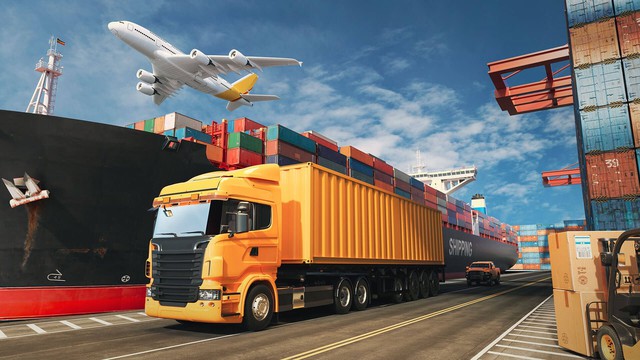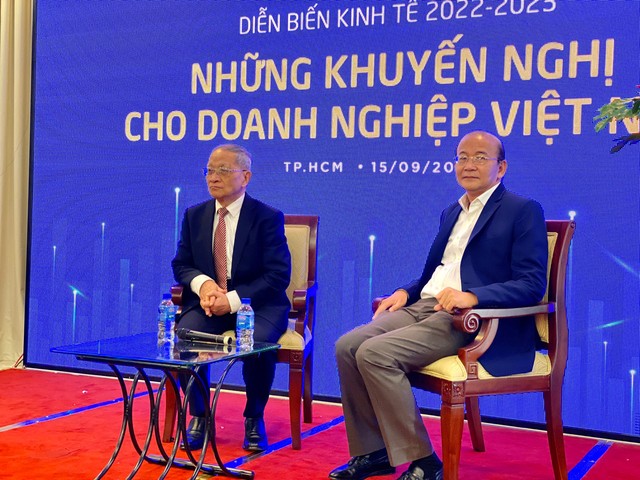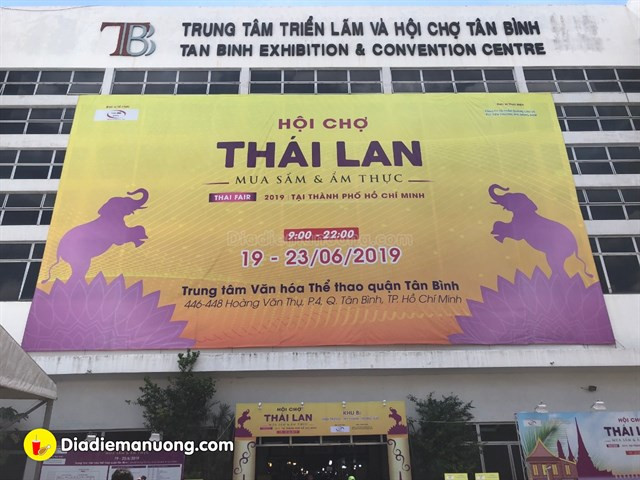According to corporate governance expert Do Hoa in the Seminar "Economic developments 2022-2023 and recommendations for Vietnamese businesses" organized by the HVNCLC Business Association; Vietnam has a very foreign dependent economy, with a large export structure.
However, if we look deeply into the data and the nature of the problem, we still mainly export raw materials and agricultural products by OEM model with low value, whether it is to the largest market, the US, or the second largest is China or Europe, Japan - Korea... And yet, according to him, at this moment, all the above-mentioned markets are facing difficulties.
About the US market
Except for a few specific agricultural and seafood products, the fact is that the US only imports high-end electronic goods – products that we can't do at the moment. So, actually, we sell quite a few products to the US market.
In terms of content, export goods with high added value such as phones and electronic components from Vietnam (if any), all come from FDI companies.
According to Economist Dr. Le Dang Doanh: Samsung says its factory in Thai Nguyen has been localized 55%, but according to a study by a prestigious university in Vietnam, the value added that Vietnamese enterprises contribute to Samsung products only about 18%.
Currently, the US economy is in a period of decline, inflation is high, purchasing power is decreasing. With the process of globalization, many developed countries in the West, including the US, have pushed cheap and polluting products to developing countries. After a while, China has "broken down" the barriers of this strategy, by forcing FDI enterprises to transfer core technologies to domestic enterprises.
With the outbreak of the US-China 'trade war' as well as the fact that China is still pursuing the 'Zero Covid' policy, the world's supply chain has been disrupted. Then when the US no longer buys Chinese goods, but buys from other suppliers, which means higher prices than before.
Besides, in the past, President Donald Trump ordered many "big guys" in the US technology industry to bring production back to the US. In the future, the US will reduce the import of electronic components and technology goods from Vietnam, ASEAN and Asia. For example, currently, the US is importing a lot of chips from Taiwan, but in the future it will be different.
Samsung Factory Complex in Thai Nguyen.
About the Chinese market
Due to being heavily affected by sanctions from the US, plus a serious crisis in the real estate - finance industry and the "Zero Covid" policy, China often tightens its borders. Accordingly, their policy of closing borders is always unpredictable and it is difficult to know when they will close and when they will open, especially the border crossing.
“ In the world supply chain – farming (raw material) is the link that bears the most risks, as it is highly dependent on weather and price fluctuations. The stages of making branded products or supplying and trading are less risky. In many agricultural products exported to China, Vietnamese farmers are the growers, and Chinese traders buy them ," said Mr. Do Hoa.
About Japan - Korea market
After having FTAs, businesses from Japan - Korea are making perfect use of them: importing components from their country, assembling in Vietnam, then returning finished products to their home countries or exporting to the US. It can be said that many FDI enterprises are taking advantage of FDA better than Vietnamese enterprises!
With the Japanese - Korean market, import and export more or less depends on how it is sold to the 3rd country, how is the 3rd country's consumption capacity.
“ The Japanese economy is showing signs of decline and inflation is high. However, Japan is still a potential market, but difficult. Vietnamese enterprises must have innovative products with novel technical standards and meet Japanese quality standards in order to successfully export.
For example, with typical agricultural products of Vietnam, we also have to do good R&D to come up with something new in order to attract Japanese consumers. Or Japanese customers have any production requirements, we must also meet them. In the Mekong Delta, there are many agro-processing factories specializing in exporting to Japan, but there is almost no R&D department ,” said Mr. Do Hoa.
In summary, Japan is a market that can be exploited well despite the small volume of orders, in contrast to the US. Or roughly speaking, an order to Japan has only a few containers, each with different creations, but in return for the high price. While goods to the US are usually raw materials and in quantities often several dozen containers, the value is low.
European market
An increase in oil prices will adversely affect the export segment to Europe - America of Vietnamese enterprises. Photo: Thanhuytphcm.vn
“ We often import machinery and equipment from Europe to Vietnam for processing – doing OEM. Therefore, European enterprises clearly understand the productivity, advantages and disadvantages of each line and machine of Vietnamese enterprises. Therefore, often they have calculated it all and only leave Vietnamese businesses with a small processing fee. If a genuine Vietnamese business only specializes in OEM for the European market, it is very difficult to get rich!
To make a lot of money in the European market, we need to be a direct competitor to local businesses. To do so, we must develop R&D, produce products with high technology content; then we will get better day by day and one day we can compete with Europe ”, Mr. Do Hoa continued.
In addition, the conflict between Russia and Ukraine is also making the export situation of Vietnamese enterprises more and more difficult. Because ships have to change ports, increasing logistics costs, debt problems are also more difficult to obtain than before.
And although Europe's energy crisis and inflation are increasing, the 'technical barrier' is still there. European governments are very experienced, they often put up barriers to protect their businesses first.
According to Mr. Hoa, many Vietnamese businesses think that 'only large or global corporations are interested in oil prices, but I don't need them' is not true. Even if you only export dumplings or dragon fruit to Europe, it will be greatly affected when the price of oil moves up or down.
From Vietnam to Europe by sea takes about 40 days, from America to Europe takes about 30 days. If the price of oil is abnormally high, it may cause logistics prices to be 20-30 times higher than before. And if you weigh it, it is clear that the logistics costs are too high to compensate for the low prices of raw materials and agricultural products, Europeans will turn to importing goods from the Americas.
Likewise, if the logistics cost is too high, and the shipping time is longer, it is more likely that Americans will import tropical agricultural products from Central America instead of from Vietnam as before. Therefore, it can be said that fuel prices greatly affect Vietnam's exports to Europe and the US.
Mr. Do Hoa (right) in the Seminar on 'Economic developments 2022-2023 and recommendations for Vietnamese businesses'.
“ We imagine simply, the market has high-end, mid-range and low-priced goods. In tough times like these, the demand for cheap prices is more than high-end and mid-range; prefer to buy domestic products instead of imported ones, because consumers do not want to pay more. European businesses that come to Vietnam to order also ask that the price does not increase, although everything is increasing rapidly.
In response, businesses can launch other brands, in addition to what is already available such as high-end or medium; buy raw materials from other suppliers and switch to the low-priced segment or work hard to sell at no profit, rather than reduce the price. We can sacrifice profits but not market share. Having market share is still me, losing market share is losing everything!
After that, we will gradually reduce prices, keep the average brand as a way to communicate, low-cost products to fight and keep market share , "said Mr. Do Hoa.
ASEAN MARKET WITH A LOT OF POTENTIAL
According to him, if the European or American market is difficult to pass, Vietnamese enterprises may consider returning to the ASEAN market. In fact, ASEAN is a very potential market that Vietnamese businesses have missed for many years. ASEAN is one of the regions with the largest population in the world – with countries with nearly a hundred million inhabitants like Vietnam or Indonesia.
“ From the point of view of focusing on exploiting the ASEAN market: is it true that foreign businesses are selling to Vietnam what we do not have or domestic enterprises cannot do? Reality: they sell what they have, because most businesses in the ASEAN region don't export high-tech things that Vietnam can't do.
The reason they make Vietnamese products inferior is because they do better marketing, stable quality control, better prices and better production management. If we want to 'hit' the ASEAN market, we must do as well as them. Accordingly, Vietnamese enterprises must improve their capacity, skills and purchasing strategies in order to have good and stable raw materials. In my opinion, Vietnamese enterprises can completely do it if they are determined enough, step by step. Thais or Indonesians are not so much better than us. Vietnamese instant noodles are delicious that I have not seen put on the shelves in stores and supermarkets in the surrounding countries , "said CEO of Elite Management Consulting Company.
Besides, instead of sitting there waiting for an agreement, the market is easy... CEOs need to sit down to optimize what their businesses are doing, open their minds, upgrade technology and actively apply new ones. The goal will be that we can do better today than yesterday, do as well as ASEAN.
Thai goods always have a good foothold in the Vietnamese market.
Just by reading books and watching the internet, we can also know that Japan or Korea, before the brilliant development like today, had a terrible 'plowing' period. Taiwan too, they have an effort to speed up, upgrade themselves to be able to do what their colleagues in the region are doing. Vietnamese businesses must accelerate themselves, save themselves! Vietnamese businesses should not settle with what they have, or try to sit 'cut and paste' or wait for rescue because 'I was educated like this and that!'.
For example, business leaders can sit back and see if they have done well or not, and re-evaluate everything once every 3 months. 5 years ago, because the market was so stable, we only needed 1 year to evaluate. But now, if we keep doing it the old way, we will be obsolete. If the CEO doesn't shout, the employees will not automatically ask the supplier for a discount, and will be like 'at the end of the month, get the gift!'.
Just at the input stage, we save a few percent, then the production process is optimized, the technology changes, shortens the process to reduce the cost of labor and radio. Businesses should consider how good and bad it will be to buy a new machine. In Vietnamese companies, there is often a lack of the role of CFO - management accountant, so it is impossible to calculate that this machine is no longer effective.
However, Vietnamese enterprises must do it step by step: after standardizing the company and testing it for a while before digitizing, then digitization will not be a burden. Applying information technology to make human resource management accounting, manually recruiting people to do difficult jobs and using technology to evaluate personnel is also more fair. It is often said that what cannot be measured cannot be managed.
“ I speak as the person in charge of the ASEAN market for large Vietnamese enterprises for 10 years; If Vietnamese enterprises can make Vietnamese-specific brands, they can sell at any price. For example, Korean noodles sold in Vietnam are very expensive, but everyone accepts them. Vietnam's best products will still be interested in foreign markets, Kem Nghia sells well in China.
Also, I don't believe that Chinese products are dominating in Southeast Asia. Chinese goods only target the low-priced segment, while the middle and high-end segments are still a game of many goods from Thailand, Indonesia, Korea or Japan. If Vietnamese businesses know how to invest in R&D and do good marketing, they can still grab a bargain in the ASEAN market ,” concluded Mr. Do Hoa.







